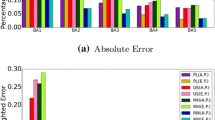Abstract.
In complex scale-free networks, ranking the individual nodes based upon their importance has useful applications, such as the identification of hubs for epidemic control, or bottlenecks for controlling traffic congestion. However, in most real situations, only limited sub-structures of entire networks are available, and therefore the reliability of the order relationships in sampled networks requires investigation. With a set of randomly sampled nodes from the underlying original networks, we rank individual nodes by three centrality measures: degree, betweenness, and closeness. The higher-ranking nodes from the sampled networks provide a relatively better characterisation of their ranks in the original networks than the lower-ranking nodes. A closeness-based order relationship is more reliable than any other quantity, due to the global nature of the closeness measure. In addition, we show that if access to hubs is limited during the sampling process, an increase in the sampling fraction can in fact decrease the sampling accuracy. Finally, an estimation method for assessing sampling accuracy is suggested.
Similar content being viewed by others
References
S.H. Strogatz, Nature 410, 268 (2001); R. Albert, A.-L. Barabási, Rev. Mod. Phys. 74, 47 (2002); S.N. Dorogovtsev, J.F.F. Mendes, Adv. Phys. 51, 1079 (2002); M.E.J. Newman, SIAM Rev. 45, 167 (2003)
R. Pastor-Satorras, A. Vespignani, Phys. Rev. Lett. 86, 3200 (2001); R. Pastor-Satorras, A. Vespignani, Phys. Rev. E 65, 036104 (2002)
L.M.A. Bettencourt, e-print arXiv:cond-mat/0304321
H. Jeong, B. Tomber, R. Albert, Z.N. Oltvai, A.-L. Barabási, Nature 407, 651 (2000)
H. Jeong, S.P. Mason, A.-L. Barabási, Z.N. Oltvai, Nature 411, 41 (2001); H. Jeong, Z.N. Oltvai, A.-L. Barabási, ComPlexUs 1, 19 (2003)
B.J. Kim, C.N. Yoon, S.K. Han, H. Jeong, Phys. Rev. E 65, 027103 (2002)
Z. Dezsö, A.-L. Barabási, Phys. Rev. E 65, 055103 (2002)
O. Frank, Models and Methods in Social Network Analysis, edited by P.J. Carrington et al. (Cambridge University Press, New York, 2005), p. 31
S. Mossa, M. Barthélémy, H.E. Stanley, L.A. Nunes Amaral, Phys. Rev. Lett. 88, 138701 (2002)
A. Clauset, C. Moore, Phys. Rev. Lett. 94, 018701 (2005); L. DallÁsta, I. Alvarez-Hamelin, A. Barrat, A. Vazquez, A. Vespignani, Theor. Comput. Sci. 355, 6 (2006); J.-L. Guillaumea, M. Latapya, D. Magoni, Comput. Networks 50, 3197 (2006); M.P.H. Stumpf, C. Wiuf, R.M. May, Proc. Natl. Acad. Sci. USA 102, 4221 (2005); J.-D.J. Han, D. Dupuy, N. Bertin, M.E. Cusick, M. Vidal, Nat. Biotechnol. 23, 839 (2005)
J. Scholz, M. Dejori, M. Stetter, M. Greiner, Physica A 350, 622 (2005)
E. Costenbader, T.W. Valente, Soc. Networks 25, 283 (2003); G. Kossinets, e-print arXiv:cond-mat/0306335
S.H. Lee, P.-J. Kim, H. Jeong, Phys. Rev. E 73, 016102 (2006)
A.S. Klovdahl, Soc. Sci. Med. 21, 1203 (1985)
M.E.J. Newman, Phys. Rev. E 64, 016131 (2001); Phys. Rev. E 64, 016132 (2001)
Y. Shavitt, E. Shir, e-print arXiv:cs.NI/0506099
K.-I. Goh, B. Kahng, D. Kim, J. Korean Phys. Soc. 46, 551 (2005)
S. Fortunato, A. Flammini, F. Menczer, e-print arXiv:cond-mat/0602081
G.K. Bhattacharyya, R.A. Johnson, Statistical Concepts and Methods (Wiley, New York, 1977)
L.C. Freeman, Soc. Networks 1, 215 (1979)
K.-I. Goh, B. Kahng, D. Kim, Phys. Rev. Lett. 87, 278701 (2001)
M. Girvan, M.E.J. Newman, Proc. Natl. Acad. Sci. USA 99, 7821 (2002)
M.E.J. Newman, S.H. Strogatz, D.J. Watts, Phys. Rev. E 64, 026118 (2001); M. Molloy, B. Reed, Random Struct. Algorithms 6, 161 (1995); Combinatorics, Probab. Comput. 7, 295 (1998)
V.E. Krebs, Connections 24, 43 (2002)
Author information
Authors and Affiliations
Corresponding author
Rights and permissions
About this article
Cite this article
Kim, PJ., Jeong, H. Reliability of rank order in sampled networks. Eur. Phys. J. B 55, 109–114 (2007). https://doi.org/10.1140/epjb/e2007-00033-7
Received:
Published:
Issue Date:
DOI: https://doi.org/10.1140/epjb/e2007-00033-7




